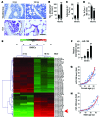MicroRNA-188 regulates age-related switch between osteoblast and adipocyte differentiation
- PMID: 25751060
- PMCID: PMC4396470
- DOI: 10.1172/JCI77716
MicroRNA-188 regulates age-related switch between osteoblast and adipocyte differentiation
Abstract
Bone marrow mesenchymal stem cells (BMSCs) exhibit an age-dependent reduction in osteogenesis that is accompanied by an increased propensity toward adipocyte differentiation. This switch increases adipocyte numbers and decreases the number of osteoblasts, contributing to age-related bone loss. Here, we found that the level of microRNA-188 (miR-188) is markedly higher in BMSCs from aged compared with young mice and humans. Compared with control mice, animals lacking miR-188 showed a substantial reduction of age-associated bone loss and fat accumulation in bone marrow. Conversely, mice with transgenic overexpression of miR-188 in osterix+ osteoprogenitors had greater age-associated bone loss and fat accumulation in bone marrow relative to WT mice. Moreover, using an aptamer delivery system, we found that BMSC-specific overexpression of miR-188 in mice reduced bone formation and increased bone marrow fat accumulation. We identified histone deacetylase 9 (HDAC9) and RPTOR-independent companion of MTOR complex 2 (RICTOR) as the direct targets of miR-188. Notably, BMSC-specific inhibition of miR-188 by intra-bone marrow injection of aptamer-antagomiR-188 increased bone formation and decreased bone marrow fat accumulation in aged mice. Together, our results indicate that miR-188 is a key regulator of the age-related switch between osteogenesis and adipogenesis of BMSCs and may represent a potential therapeutic target for age-related bone loss.
Figures









Similar articles
-
MicroRNA-130a controls bone marrow mesenchymal stem cell differentiation towards the osteoblastic and adipogenic fate.Cell Prolif. 2019 Nov;52(6):e12688. doi: 10.1111/cpr.12688. Epub 2019 Sep 26. Cell Prolif. 2019. PMID: 31557368 Free PMC article.
-
MicroRNA-133a Regulates the Viability and Differentiation Fate of Bone Marrow Mesenchymal Stem Cells via MAPK/ERK Signaling Pathway by Targeting FGFR1.DNA Cell Biol. 2021 Aug;40(8):1112-1123. doi: 10.1089/dna.2021.0206. Epub 2021 Jun 24. DNA Cell Biol. 2021. PMID: 34165368
-
Long Non-coding RNA H19 Inhibits Adipocyte Differentiation of Bone Marrow Mesenchymal Stem Cells through Epigenetic Modulation of Histone Deacetylases.Sci Rep. 2016 Jun 28;6:28897. doi: 10.1038/srep28897. Sci Rep. 2016. PMID: 27349231 Free PMC article.
-
Defining osteoblast and adipocyte lineages in the bone marrow.Bone. 2019 Jan;118:2-7. doi: 10.1016/j.bone.2018.05.019. Epub 2018 May 18. Bone. 2019. PMID: 29782940 Free PMC article. Review.
-
Bone Marrow Adipose Tissue and Skeletal Health.Curr Osteoporos Rep. 2018 Aug;16(4):434-442. doi: 10.1007/s11914-018-0451-y. Curr Osteoporos Rep. 2018. PMID: 29855795 Free PMC article. Review.
Cited by
-
Mesenchymal progenitors in osteopenias of diverse pathologies: differential characteristics in the common shift from osteoblastogenesis to adipogenesis.Sci Rep. 2016 Jul 22;6:30186. doi: 10.1038/srep30186. Sci Rep. 2016. PMID: 27443833 Free PMC article.
-
The mTORC2 signaling network: targets and cross-talks.Biochem J. 2024 Jan 25;481(2):45-91. doi: 10.1042/BCJ20220325. Biochem J. 2024. PMID: 38270460 Free PMC article. Review.
-
MicroRNA-106b inhibits osteoclastogenesis and osteolysis by targeting RANKL in giant cell tumor of bone.Oncotarget. 2015 Aug 7;6(22):18980-96. doi: 10.18632/oncotarget.4223. Oncotarget. 2015. PMID: 26053181 Free PMC article.
-
hsa_circ_0026827 Promotes Osteoblast Differentiation of Human Dental Pulp Stem Cells Through the Beclin1 and RUNX1 Signaling Pathways by Sponging miR-188-3p.Front Cell Dev Biol. 2020 Jun 26;8:470. doi: 10.3389/fcell.2020.00470. eCollection 2020. Front Cell Dev Biol. 2020. PMID: 32671065 Free PMC article.
-
miR‑483‑3p regulates osteogenic differentiation of bone marrow mesenchymal stem cells by targeting STAT1.Mol Med Rep. 2019 Nov;20(5):4558-4566. doi: 10.3892/mmr.2019.10700. Epub 2019 Sep 24. Mol Med Rep. 2019. PMID: 31702021 Free PMC article.
References
-
- Sekiya I, Larson BL, Vuoristo JT, Cui JG, Prockop DJ. Adipogenic differentiation of human adult stem cells from bone marrow stroma (MSCs). J Bone Miner Res. 2004;19(2):256–264. - PubMed
-
- Moerman EJ, Teng K, Lipschitz DA, Lecka-Czernik B. Aging activates adipogenic and suppresses osteogenic programs in mesenchymal marrow stroma/stem cells: the role of PPAR-γ2 transcription factor and TGF-β/BMP signaling pathways. Aging Cell. 2004;3(6):379–389. doi: 10.1111/j.1474-9728.2004.00127.x. - DOI - PMC - PubMed
Publication types
MeSH terms
Substances
LinkOut - more resources
Full Text Sources
Other Literature Sources
Medical
Molecular Biology Databases
Miscellaneous

